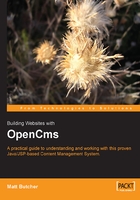
Conventions
In this book you will find a number of styles of text that distinguish between different kinds of information. Here are some examples of these styles, and an explanation of their meaning.
There are three styles for code. Code words in text are shown as follows: "Rather than get the contents of myFile with the getContents() method, we construct a new CmsXmlControlFile object".
If we have a block of code, it will be set as follows:
CmsJspActionElement cms = new CmsJspActionElement( pageContext,request,response );String myFileName = "/playground/index.html";CmsObject cmso = cms.getCmsObject();CmsFile myFile = cmso.readFile( myFileName );
When we wish to draw your attention to a particular part of a code block, the relevant lines will be made bold:
CmsJspActionElement cms = new CmsJspActionElement( pageContext, request,response );String myFileName = "/playground/index.html";CmsObject cmso = cms.getCmsObject();CmsFile myFile = cmso.readFile( myFileName );
New terms and important words are introduced in a bold-type font. Words that you see on the screen—in menus or dialog boxes, for example—appear in the text as follows: "Clicking the Next button moves you to the next screen".
Note
Tips, suggestions, or important notes appear in a box like this.
Any command-line input and output is written as follows:
mysql> create table books (name char(100), author char(50));Query OK, 0 rows affected (0.03 sec)